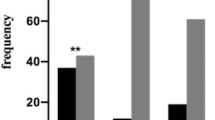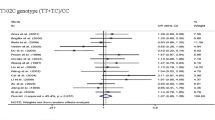Abstract
Backgrounds
Substance P, which is encoded by tachykinin precursor 1 gene (TAC1), has been implicated in the regulation of stress responses and the pathogenesis of major depressive disorder (MDD).
Methods
We evaluated the association of 10 SNPs on TAC1 with MDD susceptibility in 111 patients with MDD and 79 control subjects, and with 17-item Hamilton depression rating scale (HAMD17) score in MDD patients.
Results
In all subjects, haplotype (ht) 2 homozygous individuals showed higher plasma substance P levels than subjects carrying one or no copy of ht2. The minor allele frequency of rs1397202 was higher in patients with MDD than that in control subjects. Patients homozygous for the minor allele of rs1397202 showed significantly lower HAMD17 scores than patients carrying the common allele.
Conclusion
Our results suggest a possible involvement of genetic variants of TAC1 with the plasma level of substance P and symptom severity of MDD.
Similar content being viewed by others
References
Hirschfeld, R. M. History and evolution of the monoamine hypothesis of depression. J Clin Psychiatry 61 Suppl 6, 4–6 (2000).
Massart, R., Mongeau, R. & Lanfumey, L. Beyond the monoaminergic hypothesis: neuroplasticity and epigenetic changes in a transgenic mouse model of depression. Philos Trans R Soc Lond B Biol Sci 367, 2485–2494, doi:https://doi.org/10.1098/rstb.2012.0212 (2012).
Kramer, M. S. et al. Demonstration of the efficacy and safety of a novel substance P (NK1) receptor antagonist in major depression. Neuropsychopharmacology 29, 385–392, doi:https://doi.org/10.1038/sj.npp.1300260 (2004).
Hafizi, S., Chandra, P. & Cowen, J. Neurokinin-1 receptor antagonists as novel antidepressants: trials and tribulations. Br J Psychiatry 191, 282–284, doi:10.1192/bjp.bp.107.037879 (2007).
Ebner, K. & Singewald, N. The role of substance P in stress and anxiety responses. Amino Acids 31, 251–272, doi:https://doi.org/10.1007/s00726-006-0335-9 (2006).
DeVane, C. L. Substance P: a new era, a new role. Pharmacotherapy 21, 1061–1069 (2001).
Ebner, K., Rupniak, N. M., Saria, A. & Singewald, N. Substance P in the medial amygdala: emotional stress-sensitive release and modulation of anxiety-related behavior in rats. Proc Natl Acad Sci U S A 101, 4280–4285, doi:https://doi.org/10.1073/pnas.0400794101 (2004).
Kramer, M. S. et al. Distinct mechanism for antidepressant activity by blockade of central substance P receptors. Science 281, 1640–1645 (1998).
Geracioti, T. D., Jr. et al. Elevated cerebrospinal fluid substance p concentrations in posttraumatic stress disorder and major depression. Am J Psychiatry 163, 637–643, doi:https://doi.org/10.1176/appi.ajp.163.4.637 (2006).
Shirayama, Y., Mitsushio, H., Takashima, M., Ichikawa, H. & Takahashi, K. Reduction of substance P after chronic antidepressants treatment in the striatum, substantia nigra and amygdala of the rat. Brain Res 739, 70–78 (1996).
Kendler, K. S., Gatz, M., Gardner, C. O. & Pedersen, N. L. A Swedish national twin study of lifetime major depression. Am J Psychiatry 163, 109–114, doi:https://doi.org/10.1176/appi.ajp.163.1.109 (2006).
Lopez-Leon, S. et al. Meta-analyses of genetic studies on major depressive disorder. Mol Psychiatry 13, 772–785, doi:https://doi.org/10.1038/sj.mp.4002088 (2008).
Ebner, K., Muigg, P., Singewald, G. & Singewald, N. Substance P in stress and anxiety: NK-1 receptor antagonism interacts with key brain areas of the stress circuitry. Ann N Y Acad Sci 1144, 61–73, doi:https://doi.org/10.1196/annals.1418.018 (2008).
Zhao, Z., Yang, Y., Walker, D. L. & Davis, M. Effects of substance P in the amygdala, ventromedial hypothalamus, and periaqueductal gray on fear-potentiated startle. Neuropsychopharmacology 34, 331–340, doi:https://doi.org/10.1038/npp.2008.55 (2009).
Sergeyev, V. et al. Neuropeptide expression in rats exposed to chronic mild stresses. Psychopharmacology (Berl) 178, 115–124, doi:https://doi.org/10.1007/s00213-004-2015-3 (2005).
Hay, C. W. et al. Functional effects of polymorphisms on glucocorticoid receptor modulation of human anxiogenic substance-P gene promoter activity in primary amygdala neurones. Psychoneuroendocrinology 47, 43–55, doi:https://doi.org/10.1016/j.psyneuen.2014.04.017 (2014).
Karpouzis, A. et al. Assessment of Tachykinin Receptor 3′ Gene Polymorphism rs3733631 in Rosacea. Int Sch Res Notices 2015, 469402, doi:https://doi.org/10.1155/2015/469402 (2015).
Bilkei-Gorzo, A., Racz, I., Michel, K. & Zimmer, A. Diminished anxiety- and depression-related behaviors in mice with selective deletion of the Tac1 gene. J Neurosci 22, 10046–10052 (2002).
Marui, T. et al. Tachykinin 1 (TAC1) gene SNPs and haplotypes with autism: a case-control study. Brain Dev 29, 510–513, doi:https://doi.org/10.1016/j.braindev.2007.01.010 (2007).
Hamilton, M. A rating scale for depression. J Neurol Neurosurg Psychiatry 23, 56–62 (1960).
Hedrick, P. W. Gametic disequilibrium measures: proceed with caution. Genetics 117, 331–341 (1987).
Stephens, M., Smith, N. J. & Donnelly, P. A new statistical method for haplotype reconstruction from population data. Am J Hum Genet 68, 978–989, doi:S0002-9297 (07)61424-4 [pii]10.1086/319501 (2001).
Purcell, S. et al. PLINK: a tool set for whole-genome association and population-based linkage analyses. Am J Hum Genet 81, 559–575, doi:https://doi.org/10.1086/519795 (2007).
Nyholt, D. R. A simple correction for multiple testing for single-nucleotide polymorphisms in linkage disequilibrium with each other. Am J Hum Genet 74, 765–769, doi:https://doi.org/10.1086/383251 (2004).
Purcell, S., Cherny, S. S. & Sham, P. C. Genetic Power Calculator: design of linkage and association genetic mapping studies of complex traits. Bioinformatics 19, 149–150 (2003).
Carter, M. S. & Krause, J. E. Structure, expression, and some regulatory mechanisms of the rat preprotachykinin gene encoding substance P, neurokinin A, neuropeptide K, and neuropeptide gamma. J Neurosci 10, 2203–2214 (1990).
Duffy, R. A. Potential therapeutic targets for neurokinin-1 receptor antagonists. Expert Opin Emerg Drugs 9, 9–21, doi:10.1517/eoed.9.1.9.32956 (2004).
Frisch, P., Bilkei-Gorzo, A., Racz, I. & Zimmer, A. Modulation of the CRH system by substance P/NKA in an animal model of depression. Behav Brain Res 213, 103–108, doi:https://doi.org/10.1016/j.bbr.2010.04.044 (2010).
Ribeiro-da-Silva, A. & Hokfelt, T. Neuroanatomical localisation of Substance P in the CNS and sensory neurons. Neuropeptides 34, 256–271, doi:https://doi.org/10.1054/npep.2000.0834 (2000).
Hurd, Y. L., Keller, E., Sotonyi, P. & Sedvall, G. Preprotachykinin-A mRNA expression in the human and monkey brain: An in situ hybridization study. J Comp Neurol 411, 56–72 (1999).
Weiss, D. W. et al. Studies in psychoneuroimmunology: psychological, immunological, and neuroendocrinological parameters in Israeli civilians during and after a period of Scud missile attacks. BehavMed 22, 5–14, doi:https://doi.org/10.1080/08964289.1996.9933760 (1996).
Bondy, B. et al. Substance P serum levels are increased in major depression: preliminary results. Biol Psychiatry 53, 538–542 (2003).
Rimon, R. et al. Elevation of substance P-like peptides in the CSF of psychiatric patients. Biol Psychiatry 19, 509–516 (1984).
Lieb, K. et al. Serum levels of substance P and response to antidepressant pharmacotherapy. Pharmacopsychiatry 37, 238–239 (2004).
Zimmer, A. et al. Hypoalgesia in mice with a targeted deletion of the tachykinin 1 gene. Proc Natl Acad Sci USA 95, 2630–2635 (1998).
Lu, Y. F. et al. IFNL3 mRNA structure is remodeled by a functional non-coding polymorphism associated with hepatitis C virus clearance. Sci Rep 5, 16037, doi:https://doi.org/10.1038/srep16037 (2015).
Munoz, M. & Covenas, R. Involvement of substance P and the NK-1 receptor in human pathology. Amino Acids 46, 1727–1750, doi:https://doi.org/10.1007/s00726-014-1736-9 (2014).
Clark, J. W., Senanayake, P. D., Solomon, G. D. & Gallagher, C. Substance P: correlation of CSF and plasma levels. Headache 34, 261–264 (1994).
Chappa, A. K., Audus, K. L. & Lunte, S. M. Characteristics of substance P transport across the blood-brain barrier. Pharm Res 23, 1201–1208, doi:https://doi.org/10.1007/s11095-006-0068-1 (2006).
Li, L. et al. Plasma and cerebrospinal fluid substance P in post-stroke patients with depression. Psychiatry Clin Neurosci 63, 298–304, doi:https://doi.org/10.1111/j.1440-1819.2009.01936.x (2009).
Author information
Authors and Affiliations
Corresponding authors
Electronic supplementary material
Rights and permissions
About this article
Cite this article
Won, E., Han, KM., Kim, A. et al. The associations of TAC1 gene polymorphisms with major depressive disorder. Mol. Cell. Toxicol. 15, 129–136 (2019). https://doi.org/10.1007/s13273-019-0016-x
Received:
Accepted:
Published:
Issue Date:
DOI: https://doi.org/10.1007/s13273-019-0016-x




